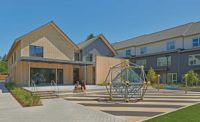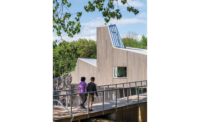Best Green Project - Google Kirkland Campus – Building D

PHOTO BY SAM VAN FLEET PHOTOGRAPHY AND DLR GROUP

PHOTO BY SAM VAN FLEET PHOTOGRAPHY AND DLR GROUP

PHOTO BY SAM VAN FLEET PHOTOGRAPHY AND DLR GROUP



Google Kirkland Campus – Building D
Kirkland, Wash.
Best Project
Lead Design Firm DLR Group
Subcontractors MacDonald Miller; University Mechanical; Evergreen Power Systems; Arch Ecology; KPFF; DCI Engineers
This five-acre campus in Kirkland was built to meet the rapid growth of Google’s engineering teams in Washington state. The facility—on a former brownfield site—is 180,000 sq ft and features 600 parking spots. Project cost is confidential.
Dave Tomson, development manager for general contractor SRM Development and SRMKII, the limited liability company that owns the facility, says brownfield remediation took about eight weeks. The process involved removing soils contaminated by chemicals during a previous tenant’s occupancy. He says the 10 to 11 spots with “gray soil” on the site were removed and the land is no longer listed as a brownfield by the Washington State Dept. of Ecology.
“It is (now) one of the cleanest sites in Kirkland,” Tomson says.
The building is on-track for LEED Platinum certification and is expected to use 30% less energy than a more traditional facility. Tomson says energy needs were substantially mitigated by addressing lighting issues and through the installation of LED lighting at every location that needed non-sun-generated illumination.
“We also have a solar farm on the roof that generates 65 kilowatts a day, or 1,000 light bulbs for an hour,” he says.
The building envelope works in conjunction with a central plant design featuring chilled beams to allow for a 55% HVAC energy savings.
Amarpreet Sethi, principal at DLR, says chilled beams were selected because of Google’s desire to exceed ASHRAE 62 requirements as well as the high plug-loads throughout the facility that require more cooling. The central plant includes air-cooled chillers, a dry cooler for heat rejection and condensing boilers for heating.
“The central plant leveraged the climate, building form and internal plug-loads by providing a heat-recovery central water-source heat pump. This is used for first-stage cooling, and heat rejection is used for simultaneous heating at the exterior,” she says.
An onsite rainwater collection system is connected to plumbing for flushing and irrigation, and contributes to a 76% water savings. The team used high recycled-content products, reclaimed wood from the site and non-toxic finishes.
“They (Google) are trying to recruit the best talent in the world and if we can enhance the employee experience, we are going to do that,” Tomson says.
The project had no major safety incidents over more than 30,000 work-hours.






